Forget about old-fashioned flea markets and fairs – tech-savvy individuals are now using apps like Offerup to trade, sell or purchase their goods online. Through online marketplaces, people can connect to buyers and sellers internationally or in their area, buy items they need at a lower price, or generate cash by selling the things they no longer use through a digital service.
Selling apps are a promising niche for entrepreneurs. Below, we will cover some examples of buy and sell apps like LetGo and Offerup, go through their key characteristics, and offer a checklist of steps for building marketplace software.
Buy and sell apps market overview
The demand for e-commerce software is huge around the globe, and with more people preferring to shop digitally, it is bound to increase in years to come. On a global scale, the e-commerce market size exceeded $9 trillion in 2019 and is predicted to reach $27.17 trillion in 2027.
Surely, a vast portion of this market belongs to the B2B segments, yet, consumer selling platforms like Offerup still account for the general growth of the e-commerce market.
Driven by the increasing number of smartphone users, the availability of broadband internet, and the shift to online shopping induced by the COVID-19 pandemic, the marketplace software segment appears to be a highly lucrative area for investment.
In the last quarter of 2021, marketers reported a 55% increase in consumer spending in eCommerce apps. According to some estimates, over 1.5 billion people are using digital solutions for shopping and selling.
Thus, there are solid reasons why building Offerup alternatives is totally worth the investment. In the next section, we will learn how Offerup works and what’s in it for end-users.
What is OfferUp?
Offerup is a marketplace app created after a merger of Offerup and LetGo. More specifically, Offerup bought LetGo in 2020 and the resulting product became much more feature rich and flexible than the original solution.
Put simply, Offerup is a local selling app available in the United States. It ships to every US region, excluding Hawaii, Alaska and Arkansas. However, users may disregard this option and concentrate on local sales.
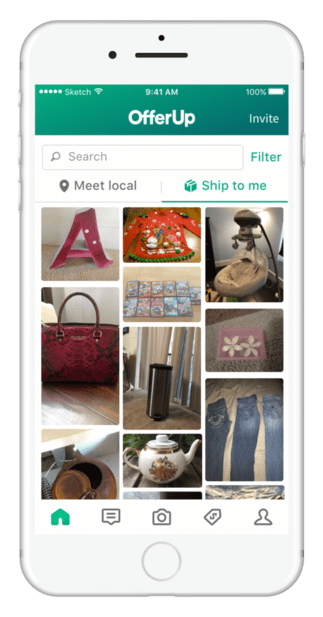
The platform allows for the creation of digital communities, and makes posting an item for purchase as easy as snapping a photo of it on a smartphone. Parties can then connect and agree on the price before concluding a deal.
The app’s 20 million active users report an excellent experience. Users can compare items offered by different sellers and enjoy various offers and discounts. As for its monetization strategy, the platform charges a percentage of each transaction, offers paid seller listings, and has a Verified Dealer program for car sales. Offerup also has delivery fees.
OfferUp alternatives
So what about other popular apps like Offerup? The range of other apps where you can buy and sell stuff is quite impressive. If you’re aiming to create a buy and sell app, check out the following services.
LetGo
Letgo is the predecessor of Offerup, the original app that Offerup is based on. The platform is immensely popular and has over 100 million users. The minimalist interface, the autofill feature, and location-based advertising ensures that your item is shown to customers in your area and make the app stand out among competitors.
The pros of LetGo include free ads; there’s only a fee for putting your item on top of the listings. On the downside, LetGo has no built-in payment service, and parties have to agree on payments on their own terms.
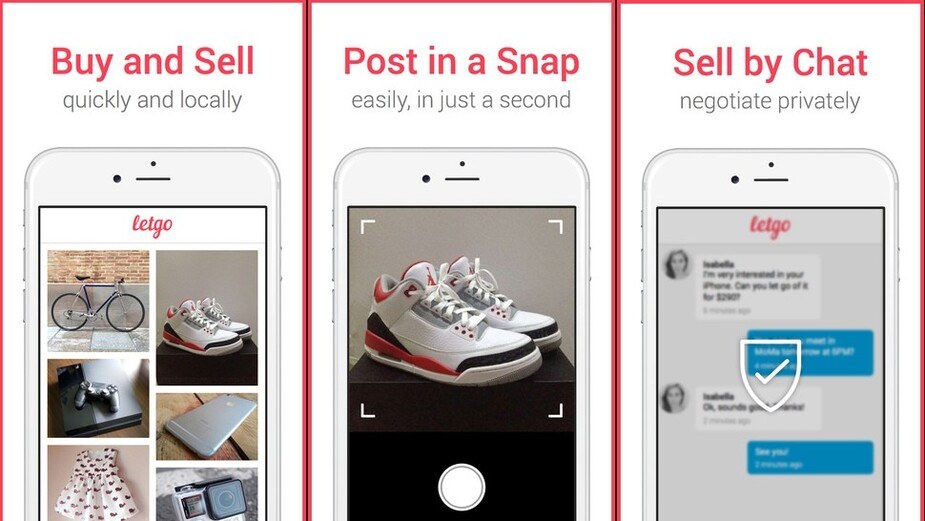
eBay
One of the major alternatives to Offerup for sellers targeting global customers. Although it is US-based, eBay ships to a number of countries around the globe, and allows people to look for products in their area with a zip code. The company is also one of the established e-commerce giants, and was among the first companies to have built an app like OfferUp.
The pros include a simple interface, PayPal integration, and a great number of categories – from apparel to consumer electronics, and global outreach. On the downside, it charges seller fees and lacks 24/7 support for users.
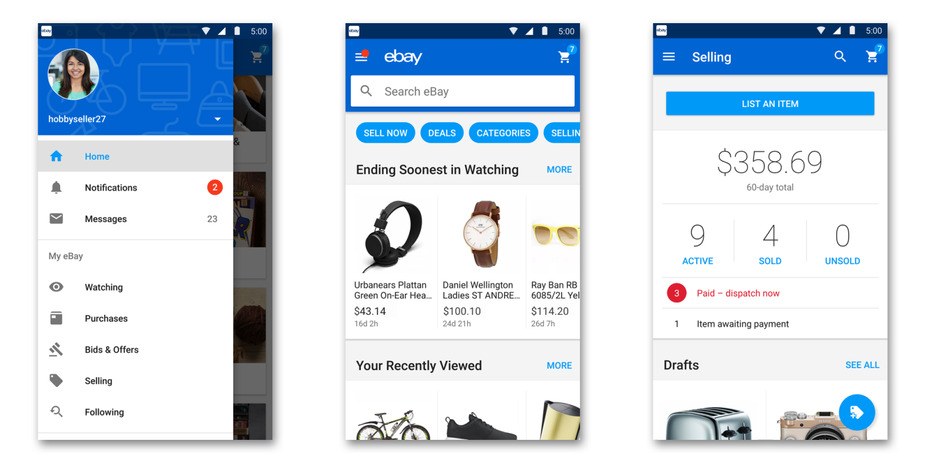
Craigslist
Another global service available in almost 70 countries worldwide. It started as an email newsletter in the mid-90s and has grown to be a marketplace with 55 million users. On Craigslist users can browse a selection of categories, which include real estate and job searches.
The main benefits include the absence of fees, simplicity and security of transactions. However, it’s not completely free, since listing in some categories costs $3-$4.

VarageSale
This platform enables customers to run a garage sale online. Intended for local use, the software allows people to view various product listings and buy used goods from sellers in their areas. Anyone is free to join, but users have to provide their real Facebook accounts to view local ads and ensure an added layer of security. The goods also undergo human inspection before being listed for purchase.
Varage Sale is simple, has a sleek and convenient UI, and claims to be almost free of fraudsters and scammers.
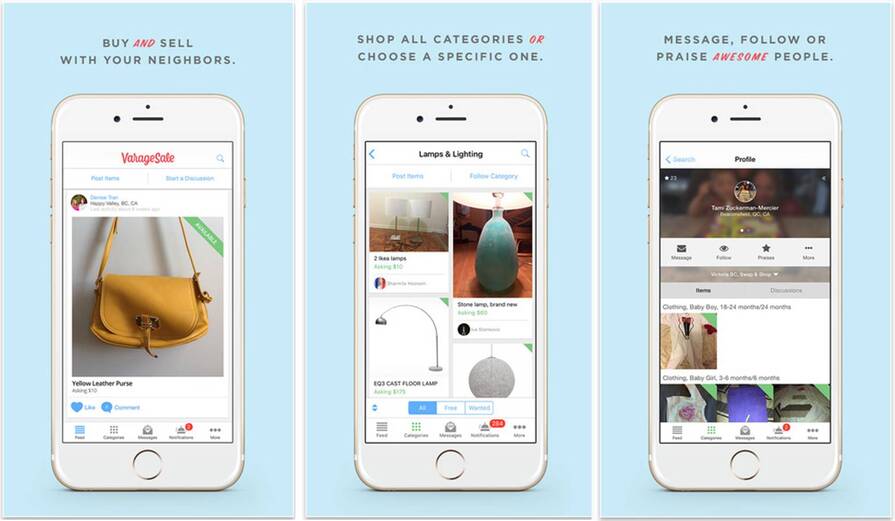
Poshmark
A service that specializes in fashion items, both new and used ones. The platform features over 6000 brands and a selection of popular product categories.
Selling with Poshmark is easy, all you have to do is select a picture of your item, and add a description and price. The software features tools and filters for customizing photos; Poshmark will also send you a package with a blank price tag once you become a seller.
The software is free to use, but it charges seller fees after the deal is closed.

Listia
It is a service where people can trade goods between themselves without using money. Trades are facilitated with Listia credits. You may also purchase things on Listia, however, users will have to buy credits in order to pay for things.
Alternatively, you may accumulate credits by signing up, listing items, giving away items, inviting friends to use the app, and connecting your account to Twitter and Facebook.

Shpock
This app enables you to look for used things like clothes, shoes, household items, consumer electronics, and even cars. Shpock is free for sellers, while buyers are charged a small fee to help ensure secure and seamless deliveries. The platform works mostly in the UK but also operates internationally.
On the downside, users complain that the app is filled with ads to an extent that navigation gets difficult and it fails to memorize previous searches.
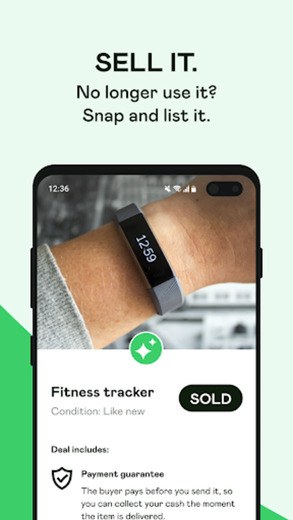
Note that selling apps like Offerup fall into three subcategories according to their regional availability. There are regional apps, platforms available nationwide in a specific country, and solutions for global sales.
Of course, there are other apps like LetGo and Offerup, and most of them work in similar ways. In the next section, we will list the essential features of digital marketplaces.
Functionality of apps like OfferUp
How to build an app like Offerup gets clearer, if you take a close look at the main characteristics of the selling apps.
The overview below should assist you in developing the functionality of your marketplace software.
- Social media signup: using social media to sign up has already become a golden standard. Most of the digital online services offer this feature. Using their social media accounts to sign up also adds trustworthiness to users.
- Home: this feature allows people to view the feed of popular items.
- User Profile: both parties should be able to set up their profiles and provide a brief description about themselves and their products.
- Categories: typically, apps like Offerup and Letgo will have them. For instance, a platform that sells apparel will feature categories like “women”, “men”, and “junior”.
- Search: people should be able to use an advanced search option to look for preferred items.
- Camera: a built-in camera will enable users to take pictures of items they want to sell and post them to their profiles.
- Shopping cart: buyers should be able to add items to the cart and view them before concluding a purchase.
- Messaging: message exchange or a voice chat between parties is one of the core features for this kind of app.
- Payment system: a payment system for transferring money is a core feature for marketplace software.
- Ratings and feedback: buying and selling things online requires a certain amount of trust. This feature helps parties prove their credibility.
- Alerts: customizable notifications about new items, promotions, and discounts.
- Item listings: users should be able to view information about a product, the seller and their ID as well as payment and shipping terms.
- Recommendations: enabling customers to view product recommendations based on their previous purchases and searches.
- Favorites: enabling users to add items to favorites so that they could purchase them later.
- Customer support: users should be able to get support, if necessary.
Do you want to built an app like Offerup?
Our experienced development team can help you create a buy and sell app similar to Offerup but with unique features in order to stand out and attract more customers!
Advanced features of buy and sell apps
If you want your app to perform more complex functions, below are some suggestions:
- Multi language support: this feature is essential if you aim to create a marketplace platform that operates internationally.
- Delivery services: a lot of firms running online that buy and sell platforms offer delivery services for their clients. Surely, introducing this feature will require careful preparation and additional planning.
- Fraud protection: even the best buy and sell apps are not entirely free of fraudsters and scammers. Introducing a fraud protection system could be a huge advantage.
- Price comparisons: allowing people to compare prices for similar products from different sellers could also be one of the advanced features that you could introduce.
- Inventory management: helping sellers manage and make an inventory of their items would be a plus.
- Virtual try ons: consider enhancing your solution with AR technology so that the buyers could visualize how the clothes or shoes would fit them.
These are the main characteristics you should consider, if you aim to create a buy and sell app. Surely, to differentiate your software from competitors, you should add unique functionality that helps meet customers’ needs in a better way. Something as simple as an attractive design and convenient UI could make your software stand out and attract a loyal audience.
Apart from the selection of features, you will need a carefully mapped-out plan in order to build an app like LetGo and Offerup. Below is a brief guide on how to create a buy and sell app platform.
A guide to create a marketplace app like OfferUp
Wondering how to create a buy and sell app? This overview will help you envision the conseсutive stages of building apps similar to Offerup.

Step 1: Research
Do your homework: look closely at your direct and indirect competitors, explore their strengths and weaknesses, and define your target user group. Insights into your audience’s age, income, and social background will help you create a top-notch selling platform.
Step 2: Choose revenue generation tactics
A critical aspect to decide on before you start developing. Because your monetization approach will impact the overall application architecture, knowing how exactly your app will be earning money is a keynote to success.
The most common strategies for earning money with marketplace apps include the following:
- Transaction fees: charging a small chunk of money from each buyer-seller transaction.
- In-app advertising: you can make money from showing ads on your platform, just ensure that your platform is not over-saturated with them.
- Delivery fees: charging money for the delivery of goods purchased through your platform.
- Featured listings: charging money for moving a particular position to the top of the list.
Step 3: Finalize the initial feature set
Next, you will need to decide which features will be included in the initial, tryout version of your app. If this version is a success, you will add more features as you work on the end product.
Step 4: Decide on a tech stack
The typical feature set for a buy and sell software will include the following:

Step 5: Build an attractive UI and UX
User experience may play a decisive role, so you will need to ensure excellent usability and a convenient UI.
Step 6: Integrate a payment system
No marketplace app is fully functional without a payment system, so your next step will involve integrating it into your platform.
Step 7: Think of viable marketing strategies
Ideally, you should start marketing your app while it is still in development. Knowing your audience will help you define your key promotion channels.
Step 8: Consider fraud prevention measures
To win users’ trust, your platform should integrate strong fraud prevention mechanisms so that users can rest assured that your app is free of scammers. Consider introducing refunds for items that never arrive or arrive in poor condition.
Final thoughts
Building sites like Offerup requires skills and experience, so you will need a reliable tech partner to create a solution with excellent UI and top-notch functionality.
Moreover, you will have to strike a delicate balance between how sophisticated your app is, and your budget. A trusted associate will help you come up with an optimal revenue plan, write a specification, develop a trial version of your app, and build an end product if your MVP is a success.
At Eastern Peak, we have the experience you need for bringing your app ideas to fruition. Looking for a trusted partner to create an Offerup alternative? Contact us now to schedule a conversation!
Read also:



